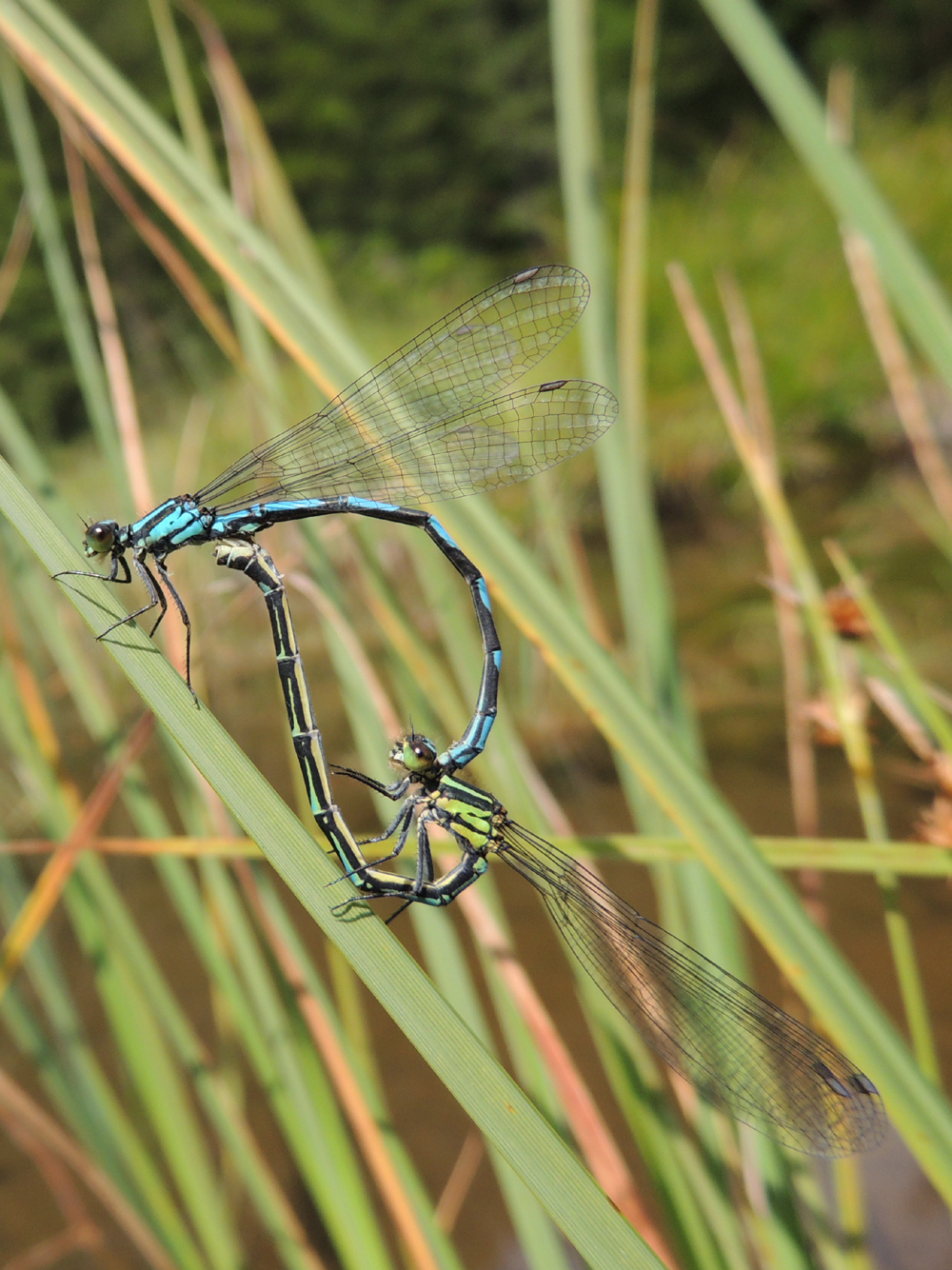Sibirische Azurjungfer
© Clemens M. Brandstetter
Die Sibirische Azurjungfer, Coenagrion hylas (Trybom 1889), ist ein eurosibirischer Faunenbestandteil, allerdings ist die Art in Mitteleuropa nur mehr in Westösterreich (Tirol) zwischen 800 und 1.600 Meter zu finden, Vorkommen im südlichen Bayern sind wahrscheinlich erloschen. Die Tiere aus Mitteleuropa wurden als Agrion freyi Bilek 1954 beschrieben; sie wurden jedoch als synonym erkannt und rangieren als Subspezies. Weitere Verbreitungsgebiete befinden sich in Asien (Sibirien, Mandschurei, Japan). Es soll hier angemerkt werden, dass sich die Larven der asiatischen Art und der in Tirol vorkommenden Exemplare unterscheiden. Die Sibirische Azurjungfer ist der Nordischen Azurjungfer (S. johanssoni) sehr ähnlich, unterscheidet sich aber von ihr durch das Verbreitungsgebiet, Grösse und Zeichnung.
 IUCN red list: "This subspecies is the rarest damselfly taxon of Europe with only few and small to very small populations. Even if there are several new findings by Müller (2000) in Tyrol as a consequence of intensive mappings in the Austrian Alps region (valley of the river Lech) the whole area inhabited by this species in Europe is very small (ca. 500 km²). The ecology of the species is very little investigated and known, but it seems to depend on complex biotopes (mountain lakes with moving waters and highly structured surroundings), which makes it very sensitive on biotope changes and impacts. Population numbers and sizes in Russia seem to be still high and in some area also very high, and the species seems to be not threatened (northern Ural Mountains, Siberia, Altay, Yakutia, Zabaikalie, partly Far East of Russia). In Japan on the contrary there are only about 20 populations left, most of them are small and also threatened (pollution, destruction of wetlands). The global area of occupancy is thought not likely to exceed 2,000 km²."
IUCN red list: "This subspecies is the rarest damselfly taxon of Europe with only few and small to very small populations. Even if there are several new findings by Müller (2000) in Tyrol as a consequence of intensive mappings in the Austrian Alps region (valley of the river Lech) the whole area inhabited by this species in Europe is very small (ca. 500 km²). The ecology of the species is very little investigated and known, but it seems to depend on complex biotopes (mountain lakes with moving waters and highly structured surroundings), which makes it very sensitive on biotope changes and impacts. Population numbers and sizes in Russia seem to be still high and in some area also very high, and the species seems to be not threatened (northern Ural Mountains, Siberia, Altay, Yakutia, Zabaikalie, partly Far East of Russia). In Japan on the contrary there are only about 20 populations left, most of them are small and also threatened (pollution, destruction of wetlands). The global area of occupancy is thought not likely to exceed 2,000 km²."
Kosterin Oleg: "Copula in lake Idar, Kamchatka, in ancient crater, mesotrophic, with peat moss quacking mires with Betula divaricata, Spiraea salicifolia, Comarum palustre, surrounded by Pinus pumila and larch taiga, in the Sredinnyi Mountain Range"

Paarungsrad im Tiroler Lechtal beobachtet – Foto: © Clemens M. Brandstetter
Larvalstadien:
Belyshev's (1973) provided key for Coenagrion larvae in which the path to C. hylas is as follows:
1 (14) Antennae 6-articled 9versus 7-articled), nodal seam perpendicular to the main trachaeal trunk (versus skewed)
3 (2) Gill nodal sean straight or wavy (versus somewhat curved to base)
5(4) Gills mate (versus translucid), nodal seam clear
9(6) nodal seam divides gill to a short distal and long proximal parts (versus equal parts)
10(11) Antennae and legs evenly coloured, light (versus light with dark patches)
Literatur:
Belyshew B. F. 1973: Strekosy sibiri. – Nauka, Nowosibirsk, 1, Teil 1 u. 2, 620 S.
Bilek A. 1954: Eine neue Agrionide aus Bayern (Odonata). – NachrBl. bayer. Ent. 3(10): 97-99.
Bilek A. 1957: Agrion freyi – eigene Art oder Subspecies von Agrion hylas Trybom?. NachrBl. bayer. Ent. 6(3): 28-29.
Heidemann H. & R. Seidenbusch 1993: Die Libellenlarven Deutschlands und Frankreichs – Handbuch für Exuviensammler. – Verlag Erna Bauer, Keltern.
Kiauta B. & M. Kiauta 1991: Biogeographic considerations on Coenagrion hylas freyi Bilek 1954 based mainly on the karyotype features of a population from North Tyrol Austria (Zygoptera Coenagrionidae). – Odonatologica. 20(4): 417-432.
Lohmann H. 1992: Ein Beitrag zum Status von Coenagrion freyi (Bilek, 1954) und zur subspezifischen Differenzierung von C. hylas (Trybom, 1889), und C. glaciale (Sélys, 1872), mit Bemerkungen zur postglazialen Ausbreitung Ostpalaärktischer Libellen (Zygoptera: Coenagrionidae). – Odonatologica 21: 421–442.
Müller, J. M. 2000: Untersuchungen zur Ökologie und Verbreitung der Sibirischen Azurjungfer (Coenagrion hylas) im Tiroler Lechtal (Odonata: Coenagrionidae). – Zulassungsarbeit zur wissenschaftlichen Prüfung für das Lehramt an Gymnasien am Institut für Experimentelle Ökologie der Tiere der Universität Ulm, 118 S.
Müller J. M. 2001: Neue Erkenntnisse zu Ökologie und Verbreitung der Sibirischen Azurjungfer Coenagrion hylas. – Mercuriale JG 2001: 9-12.
